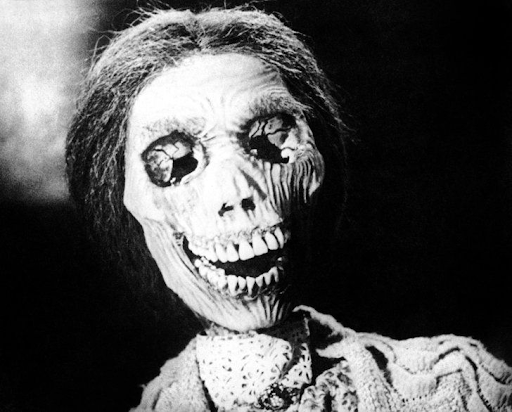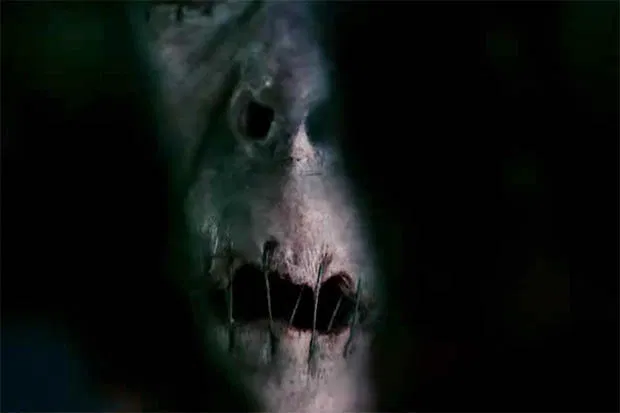The Unexpected Anatomy of Jump Scares
By Tyler Moore, Staff Writer
You’re walking alone at night, the streetlight above you flickers and cuts out. You feel a chill behind you. You turn your head ever so slowly, preparing for what could be right behind you. You look behind and...there is nothing. Sweet relief. Then, turning back around, you find the killer inches away from you. The music booms. This is a jump scare. You’re probably familiar with them. It’s a classic trick horror movies like to do to keep you on edge. To instill you with that primal fight or flight instinct. A jolt to the system. But they’ve become so common that you probably don’t even think about them anymore. They’re just expected (for some, to the movie’s detriment). But there’s a lot of history going on in jump scares. So much nuance packed into these frightful little scares that often go unnoticed and unappreciated.
Due to jumpscares being so prevalent in horror media now,it’s hard to imagine the genre existing without them. And while they had technically been around from fairly near the start of cinema, they were scarcely found until the 80's when the slasher sub genre spiked in popularity. But the first, widely agreed upon, jumpscare to appear on the screen was in the 1942 feature, Cat People directed by Jacques Tourneur.
A woman, Irena, uncovers that her fiance might be seeing another woman. Irena watches her fiance have dinner with this woman. After the dinner Irena follows the woman home. The camera stays on their feet, cutting quicker and quicker as Irena catches up to the woman. Suddenly, a bus pulls on to frame to pick the woman up. And thus the jumpscare was born. It didn’t take much back in the day to scare an audience when cinema was still generally very new. But that bus ramming itself into frame with its loud engine during a tense stalking scene certainly made audiences jump back in 1942. The producer of the film, Val Lewton, is the one who came up with the idea. The scene became so famous that this type of jumpscare was coined after her. The Lewton Bus. Now, the Lewton Bus just refers to any jumpscare that reveals itself to be something non threatening. The hand on the shoulder from a friend (Halloween). A ball hitting a window unexpectedly (It Follows). A raccoon falling from a roof in front of a window (A Quiet Place).
Cat People (1942)
Though jumpscares never took off directly after Cat People, they found their way into the mainstream through the work of Alfred Hitchcock, or more specifically, Psycho. In fact, it was one jumpscare in particular that many have observed as being the catalyst for horror to come. I’m sure most have even seen the image that this specific jump comes from. If you’re unfamiliar with the film then this might be a spoiler for you, but it comes at the end when Vera Miles is searching for Norman Bates’ mother while he is on the prowl about to catch her snooping. She sees a woman in the basement, back turned in a chair. As she spins the woman around it is revealed that Mrs. Bates is a skeleton. Until then, the audience is to believe that Mrs. Bates was the murderer. This reveal indicated to the audience just how mentally disturbed Norman Bates really was, ascending the horror of the film to another level, both with horrifying plot detail and also the sudden shock of seeing a brightly lit corpse that we, just a second ago, thought was alive. Psycho birthed the modern slasher. Influencing films such as Texas Chain Saw Massacre, Halloween, Friday the 13th, Nightmare on Elm Street. The list goes on. And so everything this monumental film did carried over into horror to come.
Psycho (1960)
The jumpscare really found its stride in the 80's and made itself a staple of the genre. With that widespread use came experimentation. During and after the 80’s, filmmakers found jumpscares to be an easy and quick way to get audiences to jump out of their seats. It was much easier than, say, creating an unsettling atmosphere with creative, yet horrifying plots. Just lower the sound, have something pop in front of the frame, and shock the audience with a loud audio cue. Rinse and repeat. And the thing about jumpscares is that they almost always work.
Due to their prevalence nowadays, it’s easy to see one being telegraphed before it happens. The sound quiets. The music cuts out. You can barely hear anything. It’s almost like the director is screaming at you that a jumpscare is about to burst onto screen. But there isn’t anything you can really do to prepare yourself for it. In fact, if you force yourself to become hypervigilant for them, you’ll likely only make the jump even worse. When you become vigilant and aware you activate your amygdala which just so happens to be connected to the part of your brain that deals with fear and anxiety. And you may think that closing your eyes will do the trick, but studies* show that it isn’t the scary image popping into frame that is doing most of the scaring, it’s the sound. It’s the loud auditory stimulus entering your ear that activates your startle response. This particular response consists of a very few amount of synapses that can be followed through the ear. And due to the small amount of synapses, the response happens much quicker than most other involuntary responses. It’s a cheap tactic that exploits a nearly unavoidable aspect of brain chemistry, but it’s an effective one.
For some, the only way to help lessen the effects of jumpscares is overexposure. Since it is prime horror season, many of you might be tempted to force yourselves to venture into the land of jumps and scares. So here’s an accelerated list of some of the most common jumpscare types that you can watch out for and learn up on. Perhaps a little bit of preparation can soften the jumps.
The Fridge Scare
The Purge (2013)
We view the character from the side as they open something like a fridge or cabinet. As they close it the scary thing is standing where the door was.
2. The Car Window Scare
Hereditary (2018)
The character is in the car and the scare jumps in front of their side window when they felt they were finally safe.
3. The Animal Scare
A sub scare of the Lewton Bus technique, this is a fake out scare where instead of something scary, it’s just an animal such as a cat or dog that jumps onto screen.
4. The Mirror Scare
American Werewolf in London (1981)
Possibly the most common and most famous type of jumpscare, The Mirror Scare is when the character either closes something like a medicine cabinet or looks over to a standing mirror and something frightening is in the mirror behind the character.
5. The Peephole Scare
The Autopsy of Jane Doe
Typically a POV shot is used with these. The character is looking through something like a peephole or keyhole and something jumps in front of the tiny opening.
6. The False Awakening
The character wakes, usually from a nightmare. The character thinks that the scares are over and it was all a dream, only to find something horrifying when they awake, revealing that they were still in a dream after all.
7. The Delayed Scare
As the name suggests, the audience is led to believe that whatever was going to scare the character has come and gone and everything is in the clear, only to have the true scare happen mere moments later.
8. Not Quite Dead
Perhaps one of the most gagged on type of jump scares, this is when the killer has seemingly been vanquished and is lying dead in front of the character. And just as the character finally relaxes, the killer reveals that they are not actually dead.
It’s true that jumpscares have lost much of their charm from when they were new to the genre, often met with eye rolls and scoffs nowadays, but that doesn’t mean they can’t still be used and done right. Even using tropes from the previous list can still often be successful. It seems to be that when jumpscares are used in a way that feel unearned or happening to shallow, cliche characters, that is when they feel the most lazy and cheap. The audience feels like they are being taken advantage of. If jumpscares are presented under an already creepy atmosphere, with an engaging plot, and are used only in moments that the story truly calls for it, then jumpscares are totally fine in my book. They are a staple in the genre for a reason. They scare us. They bring out our primal instincts and isn’t that what horror is all about anyway? So to cap this off, here is a list of some of my all time favorite jumpscares that I believe are artfully done, feel earned, and are truly scary.
The Exorcist III, the hospital long take
Mulholland Drive, the dumpster scene
It follows, the tall man
Sinister, the lawnmower video
So, the next time you pop in a horror movie, I suggest paying more attention to the jumpscares it will inevitably contain. There’s a lot going on there. But good luck not falling for it every time.
“To avoid fainting, keep repeating: It is only a movie. It is only a movie. It is only a movie.”
From the trailer for The Last House on the Left
Sources
https://www.inverse.com/article/7531-the-unexpected-physiology-of-jump-scares *
https://www.theverge.com/2012/10/31/3574592/art-of-the-jump-scare-horror-movies
https://wheresthejump.com/the-lazy-directors-guide-to-jump-scares/











